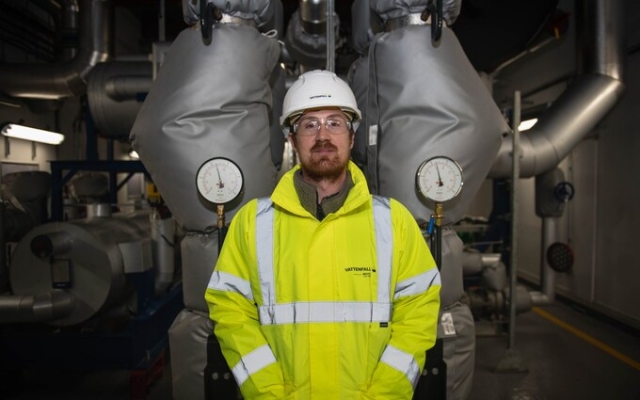 Vattenfall project manager Jason Lee says the heat pump is like a giant industrial-sized radiator. Photo: Lee Thomas < p> Situated on the shore of a floating harbor inside a large wooden shed, the giant heat pump — the largest in Britain — takes water from the river and uses it to heat surrounding buildings.
Vattenfall project manager Jason Lee says the heat pump is like a giant industrial-sized radiator. Photo: Lee Thomas < p> Situated on the shore of a floating harbor inside a large wooden shed, the giant heat pump — the largest in Britain — takes water from the river and uses it to heat surrounding buildings.
It was built by Bristol City Council but was recently taken over by Swedish state-owned energy giant Vattenfall, which is now expanding the system across the city.
“The heat pump is working hard today,” says Jason Lee, project operations manager, as we enter the large room where the unit is located.
At the plant, a maximum of 153 liters per second is taken from the river. On the day of our visit, the water temperature is about eight degrees Celsius.
The heat pump then uses the water to heat a very low boiling point chemical refrigerant (ammonia in this case), which turns into a gas and is then tightly compressed.
This in turn raises the temperature, and the gas is then used to heat pipes that carry separate water through the local area circuit.
After the heat pump has worked its magic, the originally withdrawn water is returned to the river about three to four degrees colder than before.
As long as the water temperature is about 7 degrees or higher, the machine can reach a «factor» of about three, Lee said. This means that every kilowatt of electricity supplied to the heat pump generates about three kilowatts of thermal energy in return.
This system, using a huge water tank, then pumps water through network pipes, delivering it to nearby buildings at a temperature of at least 65 degrees.
“It's like a giant industrial-sized radiator,” says Lee.
Customers already include a school, a clinic, student accommodation, a BT office and a nearby block of flats.
Currently, Bristol's network is powered by a heat pump, biomass boiler and natural gas. But in line with the city's plans to become greener, the hope is that gas could be replaced by more heat pumps, renewables or thermal power from nearby data centers and waste incinerators.
Vattenfall is also targeting other cities including Edinburgh, Glasgow and London. The company is also in talks with Dundee and Stirling about its goal of opening in five to eight cities by 2030.
The Swedish firm has long operated such heating networks in Western Europe, but is now one of several companies vying for dominance in the nascent UK market, which is tiny by comparison .
Only 2% of the heat here comes from heating networks. compared to 50% in Vattenfall's native Sweden.
But as the UK Government looks to gradually switch households away from natural gas heating as part of plans to achieve 'net zero' carbon emissions, this is likely to change.
The strategy published by ministers calls for around 18% of heat in buildings will eventually come from area networks, such as the network in Bristol.
They can provide an “efficient, cost-effective and flexible” solution for greener projects. heating, according to the International Energy Agency, ensures the clean energy on which they run.
Importantly, district heating networks can also be a solution for people who cannot get a heat pump, as the main alternative to gas boilers is being promoted government.
A typical air source heat pump will still cost a homeowner around £14,000 (excluding the £7,500 government grant) and some homes may not be suitable for them, says Jenny Curtis, managing director Vattenfall Heat UK.
“When we talk about decarbonizing heat it tends to come down to gas boilers and heat pumps, but in reality we're missing a huge part of the story,” she says.
“We need the right technologies, in the right places and at the right price. The picture will be mixed and district heating will be a huge part of the solution.”
Vattenfall's heating network history dates back to the 1890s, when one of its subsidiaries first began operating in Hamburg, Germany.
Today its networks serve more than two million homes and businesses across Europe, including cities like Amsterdam and Berlin.
In the UK, the government's heating and building strategy suggests that heating networks will be most important in populated areas such as cities.< /p>
But others believe the technology has broader potential and are pushing for it to even be considered as a direct replacement for gas heating in suburbs and rural villages.
One of them is the Kensa Group, headquartered apartment in Truro, which is engaged in the development of areas. heating networks powered by geothermal heat pumps. Earlier this year, the UK heat pump company secured a £70 million investment from Legal & General Capital and Octopus Energy.
The company uses the money to finance the construction of heating networks, the assets of which are then owned by L&G.
The company has now built heating networks for several social housing projects, including one recently built in Thurrock. But the company is also testing a heating network in the village of Stithian in Cornwall, which it hopes can become a model for others across the country.
It extracts heat from the ground through 42 wells, each about 100 meters deep. Village residents have been offered free installation of a new heating system in their homes in exchange for a monthly Kensa payment.
 The picturesque village of Stithian in Cornwall is testing a network of geothermal heat pumps. Photo: Joe Shreve
The picturesque village of Stithian in Cornwall is testing a network of geothermal heat pumps. Photo: Joe Shreve
Tamsin Lishman, chief executive of Kensa, says the approach means families still have a «warming box in the cupboard» similar to a gas boiler.
“We see huge potential in replacing the gas network,” she explains. “They work everywhere, but we find them particularly suitable for medium-density development, by which I mean classic terraced streets.”
Kensa investor L&G also believes the technology can be scaled up and is looking to become partner of the company and become a major owner of heating networks in the UK.
“They've introduced it into social housing, refurbished apartment buildings, new developments and villages, so it's really exciting that it can have such a positive impact on society,” says John Bromley, managing director of clean energy investments at L&G Capital.
“But on our part this is actually a smart investment that brings good returns.”
However, questions still remain about how heating networks will work in practice , including how consumers will operate. be protected from the risk of unfair prices.
The Heat Trust, a not-for-profit consumer advocacy organisation, warns that heating networks are de facto monopolies and customers cannot switch suppliers.
Most are also owned by landlords who outsource their operations to specialist companies, which can lead to a lack of transparency in fee calculations.
Perhaps most importantly, heat networks are not subject to electricity price caps, which proved disastrous for some consumers during the 2021 energy crisis.
Some residents reliant on heating networks have seen bills rise by up to 700 per cent as landlords have simply given up on cost increases they faced with purchasing energy on the wholesale market.
The government is currently consulting on how to regulate heating networks and protect consumers in the future. Responsibility under the Energy Act lies with Ofgem.
A government spokesman says the legislation gives Ofgem «the power to intervene in unfair prices for heating network customers», while the Secretary of State now has the power to cap prices if they will become “significantly higher compared to other heating systems.”
Despite this, regulating the many thousands of heating networks spread across the country poses an “unprecedented challenge”, warns the Heat Trust.
“It is vital to demonstrate that Ofgem is prepared to enforce,” the trust says.
Improving the efficiency of networks that can lose 30-40% of heat. will also generally be critical to preventing consumers from having to pay for poor standards.
Meanwhile, separate changes to the planning system will soon require councils to divide different areas into “heating zones”, outlining which types of heating should be given priority.
Vattenfall hopes this will help . making things easier as it expands: its flagship project in Bristol will increase from two zones to seven over the next three years.
This presents opportunities, but also big challenges, admits Vattenfall's Curtis.
“All the pieces of the puzzle fit together,” she adds. “The challenge we face is how to quickly expand the supply chain.
“But it’s coming, it’s big and exciting.”
























































Свежие комментарии